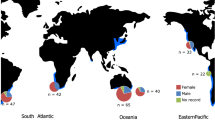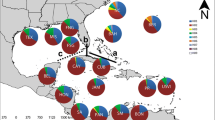Abstract
The red lionfish (Pterois volitans) is an invasive predatory marine fish that has rapidly expanded its presence in the Western Hemisphere. We collected 214 invasive red lionfish samples from nine countries and territories, including seven unpublished locations. To more comprehensively evaluate connectivity, we compiled our d-loop sequence data with 846 published sequences, resulting in 1,060 samples from 14 locations. We found low nucleotide diversity (π = 0.003) and moderate haplotype diversity (h = 0.59). Using haplotype population pairwise Φ ST tests, we analyzed possible phylogeographic breaks that were previously proposed based on other reef organisms. We found support for the Bahamas/Turks/Caicos versus Caribbean break (Φ ST = 0.12) but not for the Northwestern Caribbean, Eastern Caribbean, or US East Coast versus Bahamas breaks. The Northern Region had higher variation and more haplotypes, supporting introductions of at least five haplotypes to the region. Our wide-ranging samples showed that a lower-frequency haplotype in the Northern Region dominated the Southern Region and suggested multiple introductions, possibly to the south. We tested multiple scenarios of phylogeographic structure with analyses of molecular variance and found support for a Northern and Southern Region split at the Bahamas/Turks/Caicos versus Caribbean break (percentage of variation among regions = 8.49 %). We found that Puerto Rico clustered with the Southern Region more strongly than with the Northern Region, as opposed to previous reports. We also found the rare haplotype H03 for the first time in the southern Caribbean (Panama), indicating that either secondary releases occurred or that the low-frequency haplotypes have had time to disperse to extreme southern Caribbean locations.


Similar content being viewed by others
References
Ahrenholz DW, Morris JA (2010) Larval duration of the lionfish, Pterois volitans along the Bahamian Archipelago. Mar Biol 88:305–309. doi:10.1007/s10641-010-9647-4
Albins MA, Hixon MA (2008) Invasive Indo-Pacific lionfish Pterois volitans reduce recruitment of Atlantic coral-reef fishes. Mar Ecol Prog Ser 367:233–238. doi:10.3354/meps07620
Barson NJ, Cable J, Van Oosterhout C (2009) Population genetic analysis of microsatellite variation of guppies (Poecilia reticulata) in Trinidad and Tobago: evidence for a dynamic source-sink metapopulation structure, founder events and population bottlenecks. J Evol Biol 22:485–497. doi:10.1111/j.1420-9101.2008.01675.x
Baums IB, Miller MW, Hellberg ME (2005) Regionally isolated populations of an imperiled Caribbean coral, Acropora palmata. Mol Ecol 14:1377–1390. doi:10.1111/j.1365-294X.2005.02489.x
Betancur-R R, Acero PA, Duque-Caro H, Santos SR (2010) Phylogenetic and morphologic analyses of a coastal fish reveals a marine biogeographic break of terrestrial origin in the southern Caribbean. PLoS ONE 5:e11566. doi:10.1371/journal.pone.0011566
Betancur-R R, Hines A, Acero AP, Ortí G, Wilbur AE, Freshwater DW (2011) Reconstructing the lionfish invasion: insights into Greater Caribbean biogeography. J Biogeogr 38:1281–1293. doi:10.1111/j.1365-2699.2011.02496.x
Cowen RK, Paris CB, Srinivasan A (2006) Scaling of connectivity in marine populations. Science 311:522–527. doi:10.1126/science.1122039
Da Silva A, Luikart G, Yoccoz NG, Cohas A, Allainé D (2005) Genetic diversity-fitness correlation revealed by microsatellite analyses in European alpine marmots (Marmota marmota). Conserv Genet 7:371–382. doi:10.1007/s10592-005-9048-y
Darriba D, Taboada GL, Doallo R, Posada D (2012) jModelTest 2: more models, new heuristics and parallel computing. Nat Methods 9:772. doi:10.1038/nmeth.2109
De León R, Vane K, Bertuol P, Chamberland V, Simal F, Imms E, Vermeij M (2013) Effectiveness of lionfish removal efforts in the southern Caribbean. Endanger Species Res 22:175–182. doi:10.3354/esr00542
Excoffier L, Lischer HEL (2010) Arlequin suite ver 3.5: a new series of programs to perform population genetics analyses under Linux and Windows. Mol Ecol Resour 10:564–567. doi:10.1111/j.1755-0998.2010.02847.x
Freshwater WD, Hines A, Parham S, Wilbur A, Sabaoun M, Woodhead J, Paris CB (2009) Mitochondrial control region sequence analyses indicate dispersal from the US East Coast as the source of the invasive Indo-Pacific lionfish Pterois volitans in the Bahamas. Mar Biol 156:1213–1221. doi:10.1007/s00227-009-1163-8
Green SJ, Dulvy NK, Brooks AML, Akins JL, Cooper AB, Miller S, Côté IM (2014) Linking removal targets to the ecological effects of invaders: a predictive model and field test. Ecol Appl 24:1311–1322. doi:10.1890/13-0979.1
Guindon S, Gascuel O (2003) A simple, fast, and accurate algorithm to estimate large phylogenies by maximum likelihood. Syst Biol 52:696–704. doi:10.1080/10635150390235520
Hamner RM, Freshwater DW, Whitfield PE (2007) Mitochondrial cytochrome b analysis reveals two invasive lionfish species with strong founder effects in the western Atlantic. J Fish Biol 71:214–222. doi:10.1111/j.1095-8649.2007.01575.x
Hare JA, Churchill JH, Cowen RK, Berger TJ, Cornillon PC, Dragos P, Glenn SM, Govoni JJ, Lee TN (2002) Routes and rates of larval fish transport from the southeast to the northeast United States continental shelf. Limnol Oceanogr 47:1774–1789
Johannesson K, André C (2006) INVITED REVIEW: life on the margin: genetic isolation and diversity loss in a peripheral marine ecosystem, the Baltic Sea. Mol Ecol 15:2013–2029. doi:10.1111/j.1365-294X.2006.02919.x
Jud ZR, Layman CA (2012) Site fidelity and movement patterns of invasive lionfish, Pterois spp., in a Florida estuary. J Exp Mar Biol Ecol 414–415:69–74. doi:10.1016/j.jembe.2012.01.015
Kawecki TJ, Ebert D (2004) Conceptual issues in local adaptation. Ecol Lett 7:1225–1241. doi:10.1111/j.1461-0248.2004.00684.x
Librado P, Rozas J (2009) DnaSP v5: a software for comprehensive analysis of DNA polymorphism data. Bioinformatics 25:1451–1452. doi:10.1093/bioinformatics/btp187
Morris JA (2009) The biology and ecology of invasive Indo-Pacific lionfish. Dissertation, Noth Carolina State University, Raleigh, NC
Morris JA, Akins JL (2009) Feeding ecology of invasive lionfish (Pterois volitans) in the Bahamian archipelago. Environ Biol Fish 86:389–398. doi:10.1007/s10641-009-9538-8
Reed DH, Frankham R (2003) Correlation between fitness and genetic diversity. Conserv Biol 17:230–237. doi:10.1046/j.1523-1739.2003.01236.x
Roman J, Darling JA (2007) Paradox lost: genetic diversity and the success of aquatic invasions. Trends Ecol Evol 22:454–464. doi:10.1016/j.tree.2007.07.002
Salas E, Molina-Urena H, Walter RP, Heath DD (2010) Local and regional genetic connectivity in a Caribbean coral reef fish. Mar Biol 157:437–445. doi:10.1007/s00227-009-1330-y
Schofield P (2009) Geographic extent and chronology of the invasion of non-native lionfish (Pterois volitans [Linnaeus 1758] and P. miles [Bennett 1828]) in the Western North Atlantic and Caribbean Sea. Aquat Invasions 4:473–479. doi:10.3391/ai.2009.4.3.5
Schultz ET (1986) Pterois volitans and Pterois miles: two valid species Pterois volitans and Pterois miles: two valid species. Copeia 1986:686–690. doi:10.2307/1444950
Schultz ET, Cowen RK (1994) Recruitment of coral-reef fishes to Bermuda—local retention or long-distance transport. Mar Ecol Prog Ser 235:15–28
Schultz TF, Fitzpatrick CK, Freshwater DW, Morris JA (2013) Characterization of 18 polymorphic microsatellite loci from invasive lionfish (Pterois volitans and P. miles). Conserv Genet Res 5:599–601. doi:10.1007/s12686-013-9860-5
Taylor MS, Hellberg ME (2003) Genetic evidence for local retention of pelagic larvae in a Caribbean reef fish. Science 299:107–109
Taylor MS, Hellberg ME (2006) Comparative phylogeography in a genus of coral reef fishes: biogeographic and genetic concordance in the Caribbean. Mol Ecol 15:695–707. doi:10.1111/j.1365-294X.2006.02820.x
Toledo-Hernández C, Vélez-Zuazo X, Ruiz-Diaz CP, Patricio AR, Mège P, Navarro M, Sabat AM, Betancur-R R, Papa R (2014) Population ecology and genetics of the invasive lionfish in Puerto Rico. Aquat Invasions 9:227–237. doi:10.3391/ai.2014.9.2.12
Whitfield PE, Gardner T, Vives SP, Gilligan MR, Courtenay WR, Ray GC, Hare JA (2002) Biological invasion of the Indo-Pacific lionfish Pterois volitans along the Atlantic coast of North America. Mar Ecol Prog Ser 235:289–297
Acknowledgments
For assistance with samples, we are indebted to J. Reid, R. Bonde, A. Daniels (USGS); D. Chin and student volunteers from the Inter American University of Puerto Rico; J. Marsh and the Reef Raiders Dive Club of Naval Station Guantanamo Bay, Cuba; R. D’ Leon, manager of Bonaire Marine National Park. M. Davis provided laboratory assistance. R. Butterfield assisted with editing. P. Schofield (USGS) provided data on red lionfish sightings. A. Benson (USGS) constructed figures based on lionfish sighting data. W. Freshwater and one anonymous reviewer greatly improved this manuscript. This article does not contain any studies with live animals performed by any of the authors. Any use of trade, product, or firm names is for descriptive purposes only and does not imply endorsement by the US Government.
Author information
Authors and Affiliations
Corresponding author
Additional information
Communicated by M. Taylor.
Rights and permissions
About this article
Cite this article
Butterfield, J.S.S., Díaz-Ferguson, E., Silliman, B.R. et al. Wide-ranging phylogeographic structure of invasive red lionfish in the Western Atlantic and Greater Caribbean. Mar Biol 162, 773–781 (2015). https://doi.org/10.1007/s00227-015-2623-y
Received:
Accepted:
Published:
Issue Date:
DOI: https://doi.org/10.1007/s00227-015-2623-y




